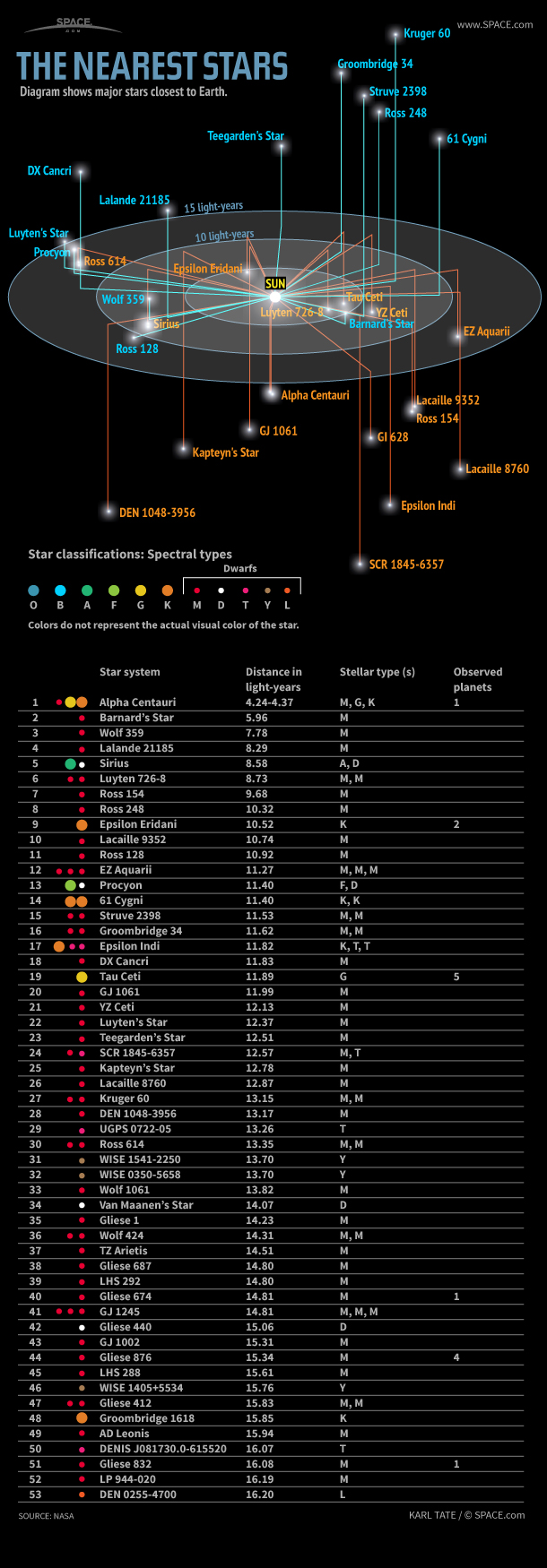The Nearest Stars to Earth (Infographic)
Exploring the stars closest to our home planet.

Stars speckle the expanse of our ever-expanding universe. While our closest star is the sun that we orbit in our little corner of the cosmos, we can peer out to see what stellar neighbors live nearby.
The nearest stars to Earth are three stars that lie about 4.37 light-years away in the Alpha Centauri triple-star system. The closest of these stars, Proxima Centauri, is just about 4.24 light-years away. (for reference, one light-year is approximately equivalent to 5.88 trillion miles (9.46 trillion kilometers)).
Suffice to say, "close" in space is far different from our Earthly definition.
Related: Does every star have planets?
Of all the stars closer than 15 light-years, only two are the same type as our sun: a G-type main-sequence star. G-type stars like our sun, also called yellow dwarf stars, typically have about 0.9 to 1.1 solar masses with surface temperatures that can range from about 9,080 degrees Fahrenheit (5,026 degrees Celsius) to 10,340 degrees F (5,726 degrees C).
The only two other G-type stars in our neighborhood are Alpha Centauri A and Tau Ceti. The majority of nearby stars are M-type stars, also known as red dwarfs, the most common stars in the universe.
Only nine of the stars in this area are bright enough to be seen by the naked human eye from Earth. These bright stars include Alpha Centauri A and B, Sirius A, Epsilon Eridani, Procyon, 61 Cygni A and B, Epsilon Indi A and Tau Ceti.
Barnard’s Star, a red dwarf 5.96 light-years away, has the largest proper motion of any known star. This means that Barnard’s Star moves rapidly against the background of more distant stars, at a rate of 10.3 seconds of arc per Earth year.
Sirius A is the brightest star in Earth’s night sky, due to its intrinsic brightness and its proximity to us. Sirius B, a white dwarf star, is smaller than Earth but it has a mass 98 percent that of our sun.
In late 2012, astronomers discovered that Tau Ceti may host five planets including one within the star’s habitable zone. Tau Ceti is the nearest single G-type star like our sun (although the Alpha Centauri triple-star system also hosts a G-type star and is much closer).
The masses of Tau Ceti’s planets range from between two and six times the mass of Earth.
This page was updated by Space.com senior writer Chelsea Gohd in Jan. 2022.
Join our Space Forums to keep talking space on the latest missions, night sky and more! And if you have a news tip, correction or comment, let us know at: community@space.com.
Join our Space Forums to keep talking space on the latest missions, night sky and more! And if you have a news tip, correction or comment, let us know at: community@space.com.
Get the Space.com Newsletter
Breaking space news, the latest updates on rocket launches, skywatching events and more!

Karl's association with Space.com goes back to 2000, when he was hired to produce interactive Flash graphics. From 2010 to 2016, Karl worked as an infographics specialist across all editorial properties of Purch (formerly known as TechMediaNetwork). Before joining Space.com, Karl spent 11 years at the New York headquarters of The Associated Press, creating news graphics for use around the world in newspapers and on the web. He has a degree in graphic design from Louisiana State University and now works as a freelance graphic designer in New York City.
